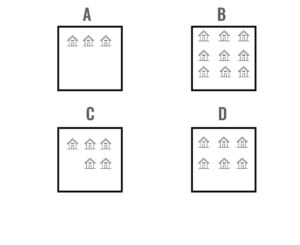
CAT4 Level A Study Guide
The CAT4 Level, A Study Guide, serves as a beacon for parents and educators navigating the unique waters of assessing natural ability in children aged 8 to 9. Unlike other exams focusing on learned knowledge, this guide sheds light on inherent skills that shape academic futures. Schools use these insights not only for streaming students but also to set robust foundations as youngsters move from primary stages upwards.
With clarity and purpose, this resource illuminates paths towards optimising learning strategies tailored individually, ensuring every child’s potential gets the attention it deserves.
CAT4 Level A Structure and Time Frame

Understanding CAT4 Level A Format
CAT4 Level A format is distinct from other tests like SATs and GCSEs because it evaluates a child’s inborn talent. Rather than testing curriculum knowledge, this test digs deep to find the true potential within each student. Educators use CAT4 results for various tasks: sorting kids by their academic strength; forecasting how they might perform on major exams such as GCSEs; and seeing who could do with more challenges or support at school.
The outcomes can uncover capabilities that aren’t always seen during regular lessons. The setup of CAT4 includes four parts called ‘batteries’: verbal reasoning, quantitative reasoning, non-verbal reasoning, and spatial awareness are all checked here through multiple-choice questions. For example, in the first section which focuses on non-verbal skills—a key part of many Year 7 entrance tests—students must group shapes based on common traits without using any extra tools like pencils.
Part two moves onto words rather than figures where young ones tackle analogies plus classification exercises designed just right for them. They’ll match meanings across different word groups but once again without help from additional resources. This assessment isn’t merely another IQ quiz—it’s a refined tool built upon data from roughly 25 thousand UK children aimed to reveal hidden abilities beyond simple learning recall.
CAT4 Level A Practice Test
Let’s dive into each CAT4 Level A category with sample questions and step-by-step explanations.
Take your time to review each answer and the explanations provided.
Free CAT4 Level A Sample Questions
Verbal Classification Sample Questions
Question 1: Which word does not belong in the group?
Options:
a) Apple
b) Banana
c) Carrot
d) Chair
Correct Answer: d) Chair
Step-by-Step Guide: We have four words here: Apple, Banana, Carrot, and Chair. Our task is to find the word that doesn’t belong with the others. Apple, Banana, and Carrot are all things we eat, right? But what about Chair? Well, a chair is not something we eat, is it? Nope, it’s something we sit on! So, the odd one out here is the word “Chair.”
Verbal Analogies Sample Questions
Question 1: Complete the analogy:
Cat is to Meow as Dog is to _______
Options:
a) Bark
b) Purr
c) Quack
d) Ribbit
Correct Answer: a) Bark
Step-by-Step Guide: Meow, meow! Let’s solve this fun analogy puzzle together! We have the word “Cat” on one side and “Meow” on the other. Now, when a cat wants to talk to us, what sound does it make? That’s right, it goes “Meow”! Now, we need to find the word on the other side of the analogy that matches the relationship between “Dog” and the sound it makes. Well, when a dog wants to talk to us, it goes “Bark”! Woof, woof! So, the correct answer is a) Bark. Great job if you chose that one!
CAT4 Level A Quantitative Reasoning Sample Questions
This section focuses on spatial reasoning abilities. It reveals the student’s ability to think with numbers.
Number Analogies Sample Questions
Question 1: Complete the analogy:
5 is to 25 as 3 is to _______.
Options:
a) 6
b) 9
c) 12
d) 15
Correct Answer: b) 9
Step-by-Step Guide: Let’s put on our math hats and solve this cool numerical analogy puzzle together! We have the number “5” on one side and “25” on the other. Now, how do we get from 5 to 25? Well, if we multiply 5 by 5, we get 25. Awesome! Now, we need to find the number on the other side of the analogy that follows the same pattern. So, if we multiply 3 by something, it should give us the missing number. Let’s try multiplying 3 by 3, and what do we get? It’s 9! So, the correct answer is b) 9. Great job if you picked that one! chose that one!
Number Series Sample Questions
Question 1: Find the next number in the series: 2, 4, 6, 8, _______.
Options:
a) 9
b) 10
c) 12
d) 14
Correct Answer: c) 12
Step-by-Step Guide: Let’s dive into the exciting world of number series! We have a series of numbers here: 2, 4, 6, 8, and there’s a missing number that we need to find. Now, what do you notice about these numbers? If we look closely, we can see that each number is 2 more than the previous one. So, to find the missing number, we need to add 2 to the last number in the series, which is 8. When we do that, we get 10! So, the next number in the series is 10. Great thinking if you picked c) 12!
CAT4 Test Year 4 Non-verbal Reasoning Sample Questions
This section tests how students solve problems using pictures and diagrams and measures how well they can think critically.
Figure Classification Sample Question
Question 1: Which figure does not belong in the group?
Options:
a) Circle
b) Triangle
c) Square
d) Star
Correct Answer: d) Star
Step-by-Step Guide: We have four figures, and our task is to find the figure that doesn’t belong. We often see circles, triangles, and squares as basic shapes, right? But what about Star? The star has those pointy ends, and it looks a bit different from the other shapes. So, the odd one out here is the figure “Star.”
Figure Matrices Sample Question
Question 1:
Find out which of the answer figures completes the figure matrix?
Options:
Correct Answer: d) Star
Step-by-Step Guide: We have an incomplete matrix and must find the figure that completes it. Take a closer look at the matrix.
The number of houses in the second picture is twice that in the first picture. On our second raw, we have 3 houses; if we know that the figure is twice the number, then 3*2=6 homes.
CAT4 Level A Spatial Ability Sample Questions
This part tests how well someone can imagine 3D things in their head.
Essential Tips for Test Preparation
To prepare for the CAT4, children must grasp how it tests their thinking. With three 45-minute papers covering verbal, non-verbal, quantitative and spatial reasoning, groundwork is key. Each main section holds puzzles gauging foundational abilities.
For verbal readiness – expressing ideas with words matters most. Regular reading boosts this skill sharply. Non-verbal parts call for understanding diagrams; here practice shapes insight into pictures used as language.
Quantitative sections need a sharp number sense: sequence recognition and numerical relationships are vital to master these queries quickly during test time. Spatial questions look at problems in three dimensions; hands-on activities like building models can hone such skills outside dry book work. The exam has firm roots – standardized on thousands of students and frequently checked against considerable data pools ensures fairness across boards.
Expert guidance suggests focusing on your child’s struggles through sub-tests. Wise preparation includes using resources like TestHQ to tackle sample questions before D-day, ensuring familiarity with the formats under timed conditions. Seek out more than just example test material at TestHQ which offers full solutions aiding not only answers but also comprehensive understanding of arriving there correctly– critical for avoiding lost points come testing day.
Scores reflect progress beyond mere figures. A raw count is translated into national percentiles, showing relative standing amongst peers. In essence parents helping kids tackle the CAT4 should mix study between books apps physical games all designed sharpen brains turn them ready problem solvers no matter what shape question takes next!
Developing Strong Verbal Reasoning Skills
In developing verbal reasoning skills for CAT4 Level A, focus on understanding and practicing different question formats. Students may face multiple-choice queries where they select the right answer from several options – a common approach in testing comprehension or critical thinking. True/false questions require one to decide if statements about a given passage are correct based solely on provided text.
Fill-in-the-blanks challenges students to pick appropriate words that best fit within sentences or paragraphs following context clues. Matching tasks involve pairing concepts from texts with corresponding choices accurately. Such diversity in questioning styles demands familiarity and strategic preparation.
Verbal analogies test ability by asking students to identify relationships between word pairs then find missing terms maintaining those links; it’s vital here to grasp how initial pairings connect when choosing answers aligning similarly. For example, linking ‘Cat’ with ‘Meow’ leads us directly toward matching ‘Dog’ with its vocalization: ‘Bark’. Understanding underlying connections is key – such as associating sun-related items under ‘Solar’, thus moon-connected ones follow suit labelled as ‘Lunar’.
Understanding common verbal reasoning exams builds confidence. These tests, such as SHL’s Verbal Reasoning Test and others, assess communication skills important for academic and vocational success.
Strategies for Quantitative Reasoning Success
To do well in quantitative reasoning, kids should build a strong base in maths. They need to practice with numbers daily. It helps them see links between problems and solutions quickly.
Working on mental maths boosts speed when solving questions without calculators. Another key strategy is spotting patterns fast; it’s vital for the CAT4 Level A test where understanding number sequences can mean easy points won or lost! Grasping data from charts and graphs also proves useful for this part of the exam because visuals often show up with numerical info that students must interpret correctly.
Regular timed drills sharpen their skills under pressure — just like during an actual test situation. Thisn’t only improves pace but reduces stress as they become familiar with working against the clock! Lastly, reviewing errors carefully offers deep learning opportunities by pinpointing exactly what went wrong so one doesn’t repeat mistakes again—very important since each question matters greatly on such exams.
Navigating the CAT4 Level A exam requires a solid grasp of its contents. The study guide from CAT4 Prep offers tailored advice for young learners as they start their academic journey. With exercises that hone verbal, non-verbal, quantitative and spatial abilities, this guide sets a firm foundation.
Pupils gain confidence through practice while parents receive valuable insights into their child’s learning style. Trust in thorough preparation to unlock potential and pave the way for educational success with support from CAT4 Prep – where early steps lead to big leaps forward.
Conclusion
Following this guide will help you get ready to do well on the CAT4 Level A Test. It gives you strategies, sample questions to practice with, and good test-taking tips.
To do well in the exam, you must know the subject, think carefully, use good strategies, and practice a lot. Remember that success comes from doing all of these things.
Good luck!
Recommended Guides
FAQ
The CAT4 Level A test is a cognitive abilities test by GL-Assessments for pupils in year 4 in UK schools and for pupils aged 7-9 in international schools.
The CAT4 Test Year 4 is a cognitive abilities test by GL-Assessments for pupils aged 7-9.
A high score on the CAT4 assessment can indicate a child’s giftedness and talent.
The test is not very hard, but some students may struggle without proper preparation.
CAT4 Level A is a fantastic tool for pinpointing students’ cognitive abilities in various domains.
With this knowledge, educators can identify gifted students and offer them the enrichment opportunities they need to thrive.
CAT4 Level A assessments can help students with learning disabilities.
These assessments adapt to each student’s abilities, which makes the evaluation highly accurate. Educators and parents find this helpful information.
The Year 4 CAT test can support the learning and growth of students with learning disabilities.

As a retired educator, I have a profound understanding of the CAT4 exam, thanks to years of training thousands of pupils. As an English and Math teacher, I have worked in international schools in Bangkok and Chiang Mai and helped students prepare for the CAT4 and MAP tests as a tutor.